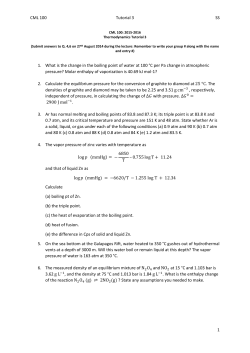
2014 Spring CHEM101 Ch5 Review Worksheet Modified by Dr
2014 Spring CHEM101 Ch5 Review Worksheet Modified by Dr. Cheng-Yu Lai, 1) An instrument used to atmospheric pressure is called a A) barometer B) manometer C) sphygmomanometer D) spectrophotometer E) spectrometer Answer: A 2) The SI unit for pressure is the A) atmosphere. B) MM Hg. C) newton. D) pascal. Answer: D 3) Which of the following equations represents "Boyle's law"? P A) =k V V B) =k T C) PV = k D) V = nk Answer: C 4) The volume of a gas is proportional to the temperature of a gas is known as A) Avogadro's Law B) Ideal Gas Law C) Charles's Law D) Boyle's Law E) Dalton's Law Answer: C 5) The volume of a gas is proportional to number of moles of a gas is known as A) Avogadro's Law B) Ideal Gas Law C) Charles's Law D) Boyle's Law E) Dalton's Law Answer: A 6) Which of the following statements is TRUE? A) Particles of different masses have the same average speed at a given temperature. B) The larger a molecule, the faster it will effuse. C) At very high pressures, a gas will occupy a larger volume than predicted by the ideal gas law. D) For a given gas, the lower the temperature, the faster it will effuse. E) None of the above statements are true. Answer: C 2014 Spring CHEM101 Ch5 Review Worksheet Modified by Dr. Cheng-Yu Lai, 7) Which of the following statements is TRUE? A) At a given temperature, lighter gas particles travel more slowly than heavier gas particles. B) The smaller a gas particle, the slower it will effuse C) The higher the temperature, the lower the average kinetic energy of the sample. D) At low temperatures, intermolecular forces become important and the pressure of a gas will be lower than predicted by the ideal gas law. E) None of the above statements are true. Answer: D 8) A gas behaves most nearly like an idea gas A) at high pressure and low temperature B) at low pressure and high temperature C) at low pressure and high temperature. D) at high pressure and high temperature Answer: A 9) F2 gas occupy 5L at 50k at 5.0 atm in a syringe, at what temperature if the F2 has a volume of 5L and pressure were doubled ? A) 200k B) 100k C) 50k D) 25k Answer: B 10) What pressure will 14.0 g of CO exert in a 3.5 L container at 75°C? ( CO Molar Mass = 28 g/mole) A) 4.1 atm B) 5.0 atm C) 6.4 atm D) 1.1 atm E) 2.3 atm Answer: A 11) What is the volume of 5.60 g of O2 at 7.78 atm and 415K? A) 1.53 L B) 565 L C) 24.5 L D) 25.0 L E) 0.766 L Answer: E 12) Determine the density of NH3 gas at 435 K and 1.00 atm. A) 2.10 g/L B) 0.477 g/L C) 0.321 g/L D) 2.24 g/L E) 0.851 g/L Answer: B 2014 Spring CHEM101 Ch5 Review Worksheet Modified by Dr. Cheng-Yu Lai, 13) Define vapor pressure. A) partial pressure of water in a liquid mixture B) partial pressure of water in a gaseous mixture C) condensation of water D) water dissolved in a liquid E) water molecules Answer: B 14) The total pressure of a gas mixture is the sum of the partial pressure of its components is known as A) Avogadro's Law B) Ideal Gas Law C) Charles's Law D) Boyle's Law E) Dalton's Law Answer: E 15) A mixture of 10.0 g of Ne and 10.0 g Ar have a total pressure of 1.6 atm. What is the partial pressure of Ne? A) 1.1 atm B) 0.80 atm C) 0.54 atm D) 0.40 atm E) 1.3 atm Answer: A 17) Determine the mass of water formed when 12.5 L NH3 (at 298 K and 1.50 atm) is reacted with 18.9 L of O2 (at 323 K and 1.1 atm). 4 NH3(g) + 5 O2(g) → 4 NO(g) + 6 H2O(g) A) 17.0 g H2O B) 20.7 g H2O C) 37.7 g H2O D) 13.8 g H2O E) 27.9 g H2O Answer: A 17) Which of the gases in the graph below has the largest molar mass? 2014 Spring CHEM101 Ch5 Review Worksheet Modified by Dr. Cheng-Yu Lai, A) A B) B C) C D) D E) There is not enough information to determine. Answer: D 18) The rate of effusion of two different gases is known as A) Avogadro's Law B) Graham's Law C) Charles's Law D) Boyle's Law E) Dalton's Law Answer: B 19) Which of the following is the principal cause of global warming? A) acid rain B) air pollution C) greenhouse effect D) ozone depletion Answer: C 20) Which of the following substances has increased markedly due to the use of fossil fuels and contributes to the greenhouse effect? A) CO2 B) SO2 C) NO2 D) O3 Answer: A 21) The principal cause of man-made ozone depletion in the stratosphere is due to A) NO2. B) CH4. C) CO2. D) Cl. Answer: D
© Copyright 2025


















